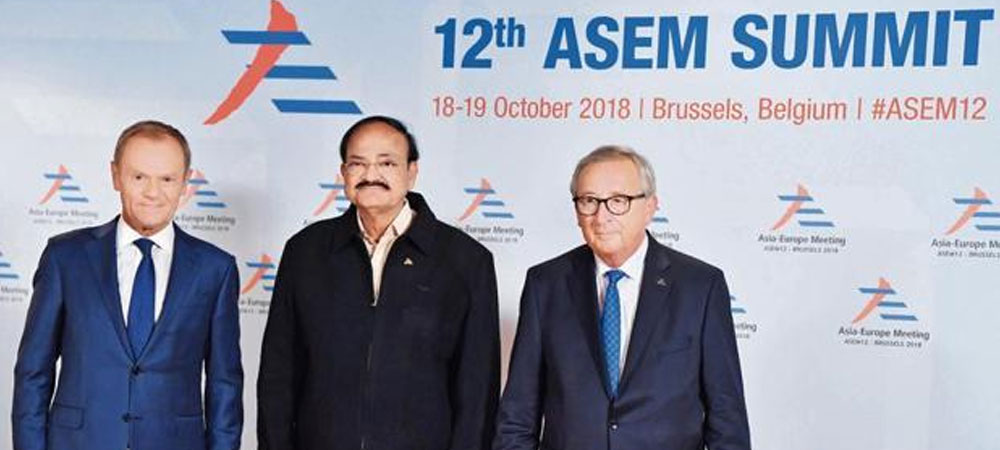 Venkaiah Naidu, the vice president, represented India at the ASEM and highlighted key concerns and priorities for the government. Photo: Reuters
Venkaiah Naidu, the vice president, represented India at the ASEM and highlighted key concerns and priorities for the government. Photo: ReutersThe Asia-Europe Meeting (ASEM) is the highest platform for Asia-Europe dialogue. As such, it could play a substantive role in fostering cooperation among the countries of the two continents. It could also enable them to play a strong role in global politics buffeted by challenges from Donald Trump’s America.
Held on 18-19 October in Brussels, the two-day biennial 12th ASEM revolved around these issues. Titled ‘Global Partners for Global Challenge’, it deliberated on how Asia and Europe could work together to safeguard and preserve multilateralism and issues relating to global commons through multilateral dialogues. Venkaiah Naidu, the vice president, represented India at the summit and highlighted key concerns and priorities for the government.
Established in 1996, ASEM functions as an informal inter-governmental dialogue platform. Through five rounds of expansion, it has registered a two-fold increase in membership, from 26 in 1996 to 53 in 2018. This also includes two regional organizations, the Asean (Association of Southeast Asian Nations) Secretariat and the European Commission. Asia has registered its robust presence with 21 countries, including its prominent major and middle powers such as China, India, Russia, Malaysia, Indonesia, Japan, and South Korea.
India joined ASEM in 2007 after it was inducted during the second round of expansion. Its cooperation with post-war Europe goes back to the 1950s when the European Union’s (EU’s) precursor, the European Economic Community, was established. India has had its own summit mechanism with the EU from 2000, which was further consolidated with the 2004 India-EU strategic partnership agreement.
ASEM’s potential lies in the fact that it encompasses 60% of the world population, more than half of global trade, and around two-thirds of global gross domestic product. Moreover, it consists of four United Nations Security Council members, all BRICS members except South Africa, and 12 of the G20 member states. However, much of this is yet to be translated into real strength.
Nevertheless, ongoing shifts in global power and geo-economics, and convulsions in the liberal international order, make ASEM increasingly relevant. Europe has been a major stakeholder in Asian growth. For one, the EU is one of the biggest trade and investment partners of Asean, India and China. It is the largest source of foreign direct investment in both India and Asean.
Both Asia and Europe are wary of the uncertainties being created by the US. Rising protectionist trade policies, withdrawal from the Paris Agreement on climate change mitigation, and Trump’s disregard for multilateral dialogue pose significant common challenges. While China is the main target of the Trump administration’s trade tariffs, the EU, Japan and India are vulnerable as well.
Increasingly disillusioned by the Trump administration, post-Brexit EU is likely to be more focused on Asia. Recent trends indicate that it is keen to be more integrated with Asian growth. Major European countries such as France and Germany are getting more involved in Asian security dynamics too.
For Delhi, relations with both China and the US have been a tightrope walk. China’s Belt and Road initiative (BRI) and Trump’s tariff barriers and H-1B visa issue are prime areas of concern for India. In that context, greater cooperation with the EU and Asian powers could open up new vistas of cooperation. Even on critical strategic issues with economic ramifications such as Iran, India, China, and the EU are largely on the same page. ASEM countries should find common ground on trade liberalization and reduction of tariff and non-tariff barriers, among other things.
Asia-Europe connectivity is another key issue. The EU has recently released a policy document on fostering physical, economic, digital, and people-to-people connectivity between Asia and Europe. Prepared by the European Commission, the document, Connecting Europe and Asia: Building blocks for an EU strategy, emphasizes the need for “sustainable, comprehensive and rules-based connectivity” to enhance “prosperity, safety and resilience of people and societies in Europe and Asia”. If the EU is able to move towards operationalizing these principles, it will have significant economic upsides.
This connectivity plan is seen by many as a response to China’s multi-billion-dollar BRI project. Major Asian stakeholders have already launched their own alternatives—to varying degrees—to BRI. In addition to their individual connectivity and outreach initiatives, Japan (Partnership for Quality Investment) and India (Sagarmala) are working together on the Asia-Africa Growth Corridor for inter-regional connectivity. With Australia and the US, the two are also working on Indo-Pacific connectivity. In this context, the EU was conspicuous by its absence. Thus, this plan is a good move, even if it has come about more slowly than it should have.
The EU strategy is a good omen for Asian countries which have been looking for a rule-based and transparent multilateral cooperation mechanism that can yield quality investments for greater intra-regional, regional, and inter-regional connectivity. It will also be interesting to see what impact the EU’s participation could have on the manner in which China is implementing the BRI.
All of this, however, comes with caveats. Europe is facing a rising tide of nationalism across its member states. Brexit is the most overt symptom, and a disruptive one, but there are many others. As for Asean, its unity is being challenged by widening internal rifts. These could prove to be significant stumbling blocks.
ASEM could play a key role in bringing Asian and European countries closer on a range of issues. This is significant at a time when the US is disrupting the gains of globalization. However, this will require political will in Asia and Europe to back multilateralism and free trade.
Rahul Mishra is senior lecturer, Asia-Europe Institute, University of Malaya.
Last Update: 23/12/2021